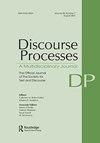穿越谁、在哪里、何时:漫画情境变化的跨文化分析
IF 2.1
2区 心理学
Q2 PSYCHOLOGY, EDUCATIONAL
引用次数: 3
摘要
理解视觉叙事需要读者追踪时间、空间位置和人物在序列中的维度。先前的研究发现,相邻面板的情境变化在不同文化背景下是不同的,但很少有研究在扩展序列中考察这种情境维度。因此,我们在来自美国、欧洲和亚洲的300多本带注释的漫画语料库中研究了情景“运行”——情景维度(时间、空间、角色)的不间断序列。我们比较了跑步比例和平均长度,发现在不同的书中,语义信息变化频繁,跑步长度与比例相关。然而,跨文化模式出现了,美国和欧洲漫画比亚洲漫画使用更多的连续运行。美国和欧洲漫画也使用了更多和更长的时间和人物连续性,而亚洲漫画则更多地使用了空间连续性。这些发现提出了关于不同文化的理解者对视觉叙事的加工策略以及视觉叙事理解的一般框架如何解释情境(非)连续性的变化的问题。本文章由计算机程序翻译,如有差异,请以英文原文为准。
Running through the Who, Where, and When: A Cross-cultural Analysis of Situational Changes in Comics
ABSTRACT Understanding visual narratives requires readers to track dimensions of time, spatial location, and characters across a sequence. Previous work has found situational changes across adjacent panels differ cross-culturally, but few works have examined such situational dimensions across extended sequences. We therefore investigated situational “runs” – uninterrupted sequences of the situational dimensions (time, space, characters) – in a corpus of 300+ annotated comics from the United States, Europe, and Asia. We compared runs’ proportion and average lengths and found that across books, semantic information changed frequently and run length correlated with proportion. Yet, cross-cultural patterns arose, with American and European comics using more continuous runs than Asian comics. American and European comics also used more and longer temporal and character continuity, while Asian comics used more spatial continuity. These findings raise questions about comprehenders’ processing strategies of visual narratives across cultures and how general frameworks of visual narrative comprehension account for variations in situational (dis)continuity.
求助全文
通过发布文献求助,成功后即可免费获取论文全文。
去求助
来源期刊

Discourse Processes
Multiple-
CiteScore
4.30
自引率
4.50%
发文量
27
期刊介绍:
Discourse Processes is a multidisciplinary journal providing a forum for cross-fertilization of ideas from diverse disciplines sharing a common interest in discourse--prose comprehension and recall, dialogue analysis, text grammar construction, computer simulation of natural language, cross-cultural comparisons of communicative competence, or related topics. The problems posed by multisentence contexts and the methods required to investigate them, although not always unique to discourse, are sufficiently distinct so as to require an organized mode of scientific interaction made possible through the journal.
 求助内容:
求助内容: 应助结果提醒方式:
应助结果提醒方式:


